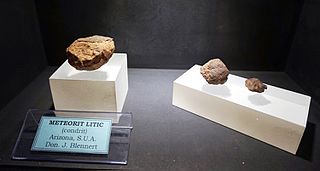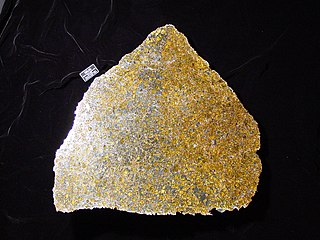Related Research Articles

In meteoritics, a meteorite classification system attempts to group similar meteorites and allows scientists to communicate with a standardized terminology when discussing them. Meteorites are classified according to a variety of characteristics, especially mineralogical, petrological, chemical, and isotopic properties.

The pallasites are a class of stony–iron meteorite. They are relatively rare, and can be distinguished by the presence of large olivine crystal inclusions in the ferro-nickel matrix.

Imilac is a pallasite meteorite found in the Atacama Desert of Northern Chile in 1822.

Iron meteorites, also called siderites or ferrous meteorites, are a type of meteorite that consist overwhelmingly of an iron–nickel alloy known as meteoric iron that usually consists of two mineral phases: kamacite and taenite. Most iron meteorites originate from cores of planetesimals, with the exception of the IIE iron meteorite group

The Fukang meteorite is a meteorite that was found in the mountains near Fukang, China in 2000. It is a pallasite—a type of stony–iron meteorite with olivine crystals. It is estimated to be 4.5 billion years old.

Brahin is a meteorite pallasite found in 1810. This is the second meteorite ever found in Russia . Sometimes it is also called Bragin or Bragim. It is quite common among collectors due to the affordable price of small partial slices.

Esquel is a meteorite found near Esquel, a Patagonian town in the northwest part of the province of Chubut in Argentina. It is a pallasite, a type of stony–iron meteorite that when cut and polished shows yellowish olivine (peridot) crystals.

Brenham is a pallasite meteorite found near Haviland, a small town in Kiowa County, Kansas, United States. Pallasites are a type of stony–iron meteorite that when cut and polished show yellowish olivine (peridot) crystals.

Krasnojarsk was the first pallasite meteorite ever found.

Huckitta is a pallasite meteorite recovered in 1937 from Huckitta Cattle Station in the Northern Territory of Australia.

Pallasovka is a pallasite meteorite found in 1990 near the town of Pallasovka, Russia.

Seymchan is a pallasite meteorite found in the dry bed of the river Hekandue, a left tributary of river Yasachnaya in the Magadan district, Russia, near the settlement of Seymchan, in June 1967.

Mbozi is an ungrouped iron meteorite found in Tanzania. It is one of the world's largest meteorites, variously estimated as the fourth-largest to the eighth-largest, it is located near the city of Mbeya in Tanzania's southern highlands. The meteorite is 3 metres (9.8 ft) long, 1 metre high, and weighs an estimated 16 metric tons.

Meteorite Men is a documentary reality television series featuring meteorite hunters Geoff Notkin and Steve Arnold. The pilot episode premiered on May 10, 2009. The full first season began on January 20, 2010, on the Science Channel. The second season premiered November 2, 2010, and season three began November 28, 2011. Professors and scientists at prominent universities including UCLA, ASU, UA, Edmonton, and other institutions, including NASA's Johnson Space Center, are featured.

The Eagle Station group is a set of pallasite meteorite specimen that do not fit into any of the other defined pallasite groups. In meteorite classification five meteorites have to be found, so they can be defined as their own group. Currently only five Eagle Station type meteorites have been found, which is just enough for a separate group.
The Vermillion meteorite is a pallasite (stony-iron) meteorite and one of two members of the pyroxene pallasite grouplet.
The pyroxene pallasite grouplet is a subdivision of the pallasite meteorites (stony-irons).

Stony-iron meteorites or siderolites are meteorites that consist of nearly equal parts of meteoric iron and silicates. This distinguishes them from the stony meteorites, that are mostly silicates, and the iron meteorites, that are mostly meteoric iron.
This is a glossary of terms used in meteoritics, the science of meteorites.
Zaisho is a meteorite whose fall in Japan in February 1898 was seen by observers on the ground. As of 2019 it remains one of only four known pallasite falls, along with Marjalahti, Mineo and Omolon.
References
- ↑ Krot, A.N. (2003). Davis, A (ed.). "Classification of Meteorites". Meteorites, Comets, and Planets: Treatise on Geochemistry (2 ed.). 1: 85 – via Elsevier-Pergamon.